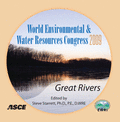Developing Probability of Failure Estimates for Stream Restoration Design Components
Publication: World Environmental and Water Resources Congress 2009: Great Rivers
Abstract
Stream restoration projects are proliferating in all regions of the country to provide improvements to streams disturbed by highway construction, urbanization, and channel modifications. The morphologically-based natural channel design method is commonly used to design stream restoration projects; however, the design approach is often vague, qualitative, and lacking in guidance. This can lead to an increase in project uncertainty and costs. A two-step method of incorporating uncertainty and risk in stream restoration design has been developed as a combination of Design Failure Modes and Effects Analysis (DFMEA) and risk quantification. The purpose of DFMEA is to prioritize failures in accordance with their risk. The definition of risk contains two components: (1) probability of failure and (2) consequence of failure. Probability of failure of stream restoration design components is often difficult to determine due to lack of published failure data. In the existing risk assessment method, the likelihood of occurrence ratings from the DFMEA are used to estimate the probability of failure. A set of tasks were carried out to improve the application of the two-step risk assessment method by developing better estimates of probability of failure for stream restoration design components. A literature review was performed to compile potential failure modes, causes of failure, associated predictor variables, and uncertainty in the predictor variables for stream restoration design components. Following this, advanced probabilistic techniques, namely Logistic Regression Analysis (LRA) and Monte Carlo Simulation (MCS), were applied to develop improved failure probabilities for stream restoration design. MCS was used to incorporate the results of the literature review and to select values for the predictor variables for use in the LRA. The LRA provided a model that was used for prediction of the probability of occurrence of an event. The results were incorporated into the existing risk assessment method to create a better decision making tool for stream restoration design. The incorporation of the resulting risk assessment method in the design phase of stream restoration projects can be important to decision making and will improve the likelihood of success.
Get full access to this article
View all available purchase options and get full access to this chapter.
Information & Authors
Information
Published In
Copyright
© 2009 American Society of Civil Engineers.
History
Published online: Apr 26, 2012
ASCE Technical Topics:
- Analysis (by type)
- Channels (waterway)
- Design (by type)
- Disaster risk management
- Ecological restoration
- Ecosystems
- Engineering fundamentals
- Environmental engineering
- Failure analysis
- Failure modes
- Forensic engineering
- Hydraulic design
- Hydraulic engineering
- Hydraulic structures
- Mathematics
- Probability
- Risk management
- River engineering
- Rivers and streams
- Stream channels
- Structural engineering
- Water and water resources
- Waterways
Authors
Metrics & Citations
Metrics
Citations
Download citation
If you have the appropriate software installed, you can download article citation data to the citation manager of your choice. Simply select your manager software from the list below and click Download.
